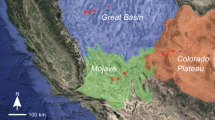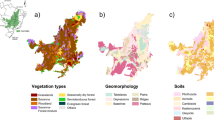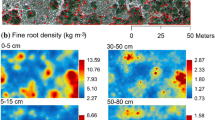Abstract
Context
In the Rio Grande Plains of southern Texas, subtropical savanna vegetation is characterized by a two-phase pattern consisting of discrete woody patches embedded within a C4 grassland matrix. Prior trench transect studies have suggested that, on upland portions of the landscape, large woody patches (groves) occur on non-argillic inclusions, while small woody patches (clusters) are dispersed among herbaceous vegetation where the argillic horizon is present.
Objective
To test whether spatial heterogeneity of subsurface soil texture drives the landscape-scale pattern of woody patches in this subtropical savanna.
Methods
Landscape-scale spatial patterns of soil texture were quantified by taking spatially-specific soil samples to a depth of 1.2 m in a 160 m × 100 m plot. Kriged maps of soil texture were developed, and the locations of non-argillic inclusions were mapped.
Results
Visual comparison of kriged maps of soil texture to a high resolution aerial photograph of the study area revealed that groves were present exclusively where the non-argillic inclusions were present. This clear visual relationship was further supported by positive correlations between soil sand concentration in the lower soil layers and total fine root biomass which mapped the locations of groves.
Conclusions
Subsurface non-argillic inclusions may favor the establishment and persistence of groves by enabling root penetration deeper into the profile, providing greater access to water and nutrients that are less accessible on those portions of the landscape where the argillic horizon is present, thereby regulating the distribution of grove vegetation and structuring the evolution of this landscape.







Similar content being viewed by others
References
Anadón JD, Sala OE, Turner BL, Bennett EM (2014) Effect of woody-plant encroachment on livestock production in North and South America. Proc Natl Acad Sci USA 111:12948–12953
Archer S (1995) Tree-grass dynamics in a Prosopis-thornscrub savanna parkland: reconstructing the past and predicting the future. Ecoscience 2:83–99
Archer S, Scifres C, Bassham CR, Maggio R (1988) Autogenic succession in a subtropical savanna: conversion of grassland to thorn woodland. Ecol Monogr 58:111–127
Archer SR, Boutton TW, Hibbard K (2001) Trees in grasslands: biogeochemical consequences of woody plant expansion. In: Schulze E-D, Harrison SP, Heimann M, Holland EA, Lloyd J, Prentice IC, Schimel D (eds) Global biogeochemical cycles in the climate system. Academic Press, San Diego, pp 115–137
Arshad MA (1982) Influence of the termite Macrotermes michaelseni (Sjöst) on soil fertility and vegetation in a semi-arid savannah ecosystem. Agro-ecosystems 8:47–58
Bai E, Boutton TW, Liu F, Wu XB, Archer SR (2012) Spatial patterns of soil δ13C reveal grassland-to-woodland successional processes. Org Geochem 42:1512–1518
Bai E, Boutton TW, Wu XB, Liu F, Archer SR (2009) Landscape-scale vegetation dynamics inferred from spatial patterns of soil δ13C in a subtropical savanna parkland. J Geophys Res. doi:10.1029/2008JG000839
Bonachela JA, Pringle RM, Sheffer E, Coverdale TC, Guyton JA, Caylor KK, Levin SA, Tarnita CE (2015) Termite mounds can increase the robustness of dryland ecosystems to climatic change. Science 347:651–655
Boutton TW, Archer SR, Midwood AJ (1999) Stable isotopes in ecosystem science: structure, function and dynamics of a subtropical savanna. Rapid Commun Mass Spectrom 13:1263–1277
Boutton TW, Archer SR, Midwood AJ, Zitzer SF, Bol R (1998) δ13C values of soil organic carbon and their use in documenting vegetation change in a subtropical savanna ecosystem. Geoderma 82:5–41
Boutton TW, Liao JD, Filley TR, Archer SR (2009) Belowground carbon storage and dynamics accompanying woody plant encroachment in a subtropical savanna. In: Lal R, Follett R (eds) Soil carbon sequestration and the greenhouse effect, vol 2. Soil Science Society of America, Madison, pp 181–205
Brown JR, Archer S (1990) Water relations of a perennial grass and seedling vs adult woody plants in a subtropical savanna, Texas. Oikos 57:366–374
Buitenwerf R, Bond WJ, Stevens N, Trollope WSW (2012) Increased tree densities in South African savannas: >50 years of data suggests CO2 as a driver. Global Change Biol 18:675–684
Dutilleul P, Clifford P, Richardson S, Hemon D (1993) Modifying the t test for assessing the correlation between two spatial processes. Biometrics 49:305–314
Haase P (1995) Spatial pattern analysis in ecology based on Ripley’s K-function: introduction and methods of edge correction. J Veg Sci 6:575–582
Hamerlynck EP, McAuliffe JR, Smith SD (2000) Effects of surface and sub-surface soil horizons on the seasonal performance of Larrea tridentata (creosotebush). Funct Ecol 14:596–606
Higgins SI, Bond WJ, Trollope WS (2000) Fire, resprouting and variability: a recipe for grass–tree coexistence in savanna. J Ecol 88:213–229
Konaté S, Le Roux X, Tessier D, Lepage M (1999) Influence of large termitaria on soil characteristics, soil water regime, and tree leaf shedding pattern in a West African savanna. Plant Soil 206:47–60
Littell RC, Milliken GA, Stroup WW, Wolfinger RD, Schabenberger O (2006) SAS for mixed models. SAS Institute Inc., Cary, NC, USA
Liu F, Wu X, Bai E, Boutton TW, Archer SR (2010) Spatial scaling of ecosystem C and N in a subtropical savanna landscape. Global Change Biol 16:2213–2223
Liu F, Wu X, Bai E, Boutton TW, Archer SR (2011) Quantifying soil organic carbon in complex landscapes: an example of grassland undergoing encroachment of woody plants. Global Change Biol 17:1119–1129
Lobry de Bruyn LA, Conacher AJ (1990) The role of termites and ants in soil modification-a review. Soil Res 28:55–93
Loomis LE (1989) Influence of heterogeneous subsoil development on vegetation patterns in a subtropical savanna parkland, Texas. Dissertation, Texas A&M University
McAuliffe JR (1994) Landscape evolution, soil formation, and ecological patterns and processes in Sonoran Desert bajadas. Ecol Monogr 64:111–148
McCulley RL, Archer SR, Boutton TW, Hons FM, Zuberer DA (2004) Soil respiration and nutrient cycling in wooded communities developing in grassland. Ecology 85:2804–2817
Miller GR, Chen X, Rubin Y, Ma S, Baldocchi DD (2010) Groundwater uptake by woody vegetation in a semiarid oak savanna. Water Resour Res 46:W10503
Pringle RM, Doak DF, Brody AK, Jocqué R, Palmer TM (2010) Spatial pattern enhances ecosystem functioning in an African savanna. PLoS Biol 8:e1000377
R Development Core Team (2011) R: a language and environment for statistical computing. R Foundation for Statistical Computing, Vienna
Ratajczak Z, Nippert JB, Collins SL (2012) Woody encroachment decreases diversity across North American grasslands and savannas. Ecology 93:697–703
Ripley BD (1981) Spatial statistics. Wiley, Hoboken
Rosenberg MS, Anderson CD (2011) PASSaGE: pattern analysis, spatial statistics and geographic exegesis Version 2. Methods Ecol Evol 2:229–232
Sankaran M, Ratnam J, Hanan NP (2004) Tree–grass coexistence in savannas revisited—insights from an examination of assumptions and mechanisms invoked in existing models. Ecol Lett 7:480–490
Sankaran M, Hanan NP, Scholes RJ, Ratnam J, Augustine DJ, Cade BS, Gignoux J, Higgins SI, Roux XL, Ludwig F, Ardo J, Banyikwa F, Bronn A, Bucini G, Caylor KK, Coughenour MB, Diouf A, Ekaya W, Fedral CJ, February EC, Frost PGH, Hiernaux P, Hrabar H, Metzger KL, Prins HHT, Ringrose S, Sea W, Tews J, Worden J, Zambatis N (2005) Determinants of woody cover in African savannas. Nature 438:846–849
Sankaran M, Augustine DJ, Ratnam J (2013) Native ungulates of diverse body sizes collectively regulate long-term woody plant demography and structure of a semi-arid savanna. J Ecol 101:1389–1399
Scheiter S, Higgins SI, Beringer J, Hutley LB (2015) Climate change and long-term fire management impacts on Australian savannas. New Phytol 205:1211–1226
Schenk HJ, Jackson RB (2005) Mapping the global distribution of deep roots in relation to climate and soil characteristics. Geoderma 126:129–140
Schlesinger WH, Raikes JA, Hartley AE, Cross AF (1996) On the spatial pattern of soil nutrients in desert ecosystems. Ecology 77:364–374
Scholes RJ, Archer SR (1997) Tree-grass interactions in savannas. Annu Rev Ecol Evol Syst 28:517–544
Sheldrick BH, Wang C (1993) Particle size distribution. In: Carter MR (ed) Soil sampling and methods of analysis. Canadian Society of Soil Science, Lewis Publishers, Ann Arbor, pp 499–511
Sileshi GW, Arshad MA, Konaté S, Nkunika PO (2010) Termite-induced heterogeneity in African savanna vegetation: mechanisms and patterns. J Veg Sci 21:923–937
Soper FM, Boutton TW, Sparks JP (2015) Investigating patterns of symbiotic nitrogen fixation during vegetation change from grassland to woodland using fine scale δ15N measurements. Plant Cell Environ 38:89–100
Stokes CJ (1999) Woody plant dynamics in a south Texas savanna: pattern and process. Dissertation, Texas A&M University
Turner JS, Marais E, Vinte M, Mudengi A, Park WL (2006) Termites, water and soils. Agricola 16:40–45
Van Auken OW (2000) Shrub invasions of North American semiarid grasslands. Annu Rev Ecol Evol Syst 31:197–215
Volder A, Briske DD, Tjoelker MG (2013) Climate warming and precipitation redistribution modify tree–grass interactions and tree species establishment in a warm-temperate savanna. Global Change Biol 19:843–857
Watts SE (1993) Rooting patterns of co-occurring woody plants on contrasting soils in a subtropical savanna. Thesis, Texas A&M University
Wu XB, Archer SR (2005) Scale-dependent influence of topography-based hydrologic features on patterns of woody plant encroachment in savanna landscapes. Landscape Ecol 20:733–742
Zhang HY, Yu Q, Lü XT, Trumbore SE, Yang JJ, Han XG (2016) Impacts of leguminous shrub encroachment on neighboring grasses include transfer of fixed nitrogen. Oecologia 180:1213–1222
Zou CB, Barnes PW, Archer S, McMurtry CR (2005) Soil moisture redistribution as a mechanism of facilitation in savanna tree–shrub clusters. Oecologia 145:32–40
Acknowledgements
Yong Zhou was supported by the Sid Kyle Graduate Merit Assistantship from Department of Ecosystem Science and Management, Texas A&M University. We thank two anonymous reviewers for helpful comments that improved the manuscript. We thank also David McKown, manager of the La Copita Research Area, for assistance with on-site logistics, and Dr. Ayumi Hyodo and Ryan Mushinski for assistance with lab work. This research was supported by an NSF Doctoral Dissertation Improvement Grant (DEB/DDIG-1600790), the Howard McCarley Student Research Award from the Southwestern Association of Naturalist, an Exploration Fund Grant from the Explorers Club, and by USDA/NIFA Hatch Project (1003961).
Author information
Authors and Affiliations
Corresponding author
Electronic supplementary material
Below is the link to the electronic supplementary material.
Rights and permissions
About this article
Cite this article
Zhou, Y., Boutton, T.W., Wu, X.B. et al. Spatial heterogeneity of subsurface soil texture drives landscape-scale patterns of woody patches in a subtropical savanna. Landscape Ecol 32, 915–929 (2017). https://doi.org/10.1007/s10980-017-0496-9
Received:
Accepted:
Published:
Issue Date:
DOI: https://doi.org/10.1007/s10980-017-0496-9




